When remodeling a bathroom, the vanity is often the piece that defines the entire space. It’s more than a cabinet with a sink. It’s where style, function, and layout all come together. Choosing the right one can make a small bathroom feel larger, add much-needed storage, and tie the whole design together.
In this guide, you’ll learn about the main types of bathroom vanities, how they’re installed, the best materials to use, and which options work best for homes across Anne Arundel County, Maryland and beyond.
Main Types of Bathroom Vanities
Most bathroom vanities fall into a few key categories based on how they’re built and installed. Each has its own purpose, look, and level of maintenance.
1. Freestanding Vanity
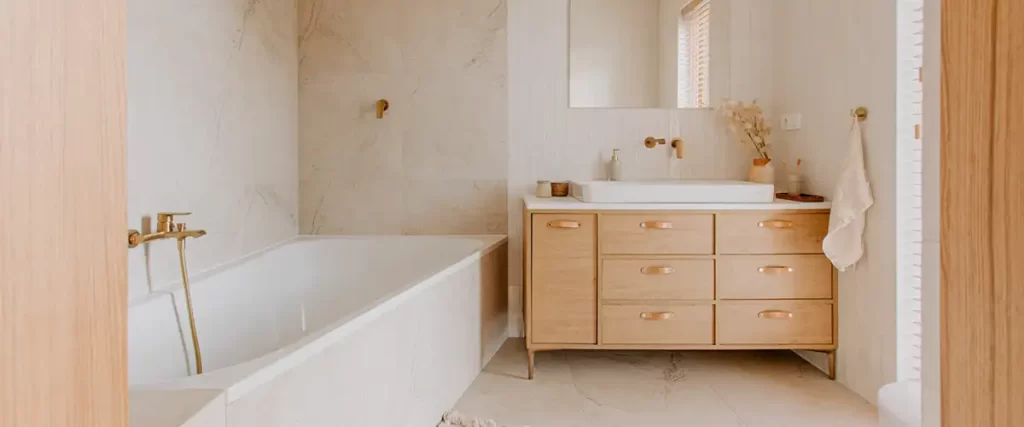
The most common and versatile choice, freestanding vanities look like standalone furniture pieces. Often resembling dressers or cabinets. They sit directly on the floor and work well in both small and large bathrooms.
Key Benefits:
They offer generous storage, are easier to install than built-in units, and come in a wide range of finishes. Many Maryland homeowners prefer stained wood or painted finishes to match traditional or transitional interiors.
2. Built-In (Cabinet-Style) Vanity
A built-in vanity is designed as part of the bathroom’s permanent structure. It’s installed flush against one or more walls, often customized to fit a specific layout, including corners or long walls. These vanities typically combine countertops, sinks, and cabinetry into a single, cohesive unit.
Key Benefits:
Built-in vanities maximize storage and countertop space, making them ideal for larger or shared bathrooms. They can be tailored to any shape, including L-shaped or corner configurations, and often include double sinks, drawers, and shelving for efficient organization.
3. Wall-Mounted (Floating) Vanity
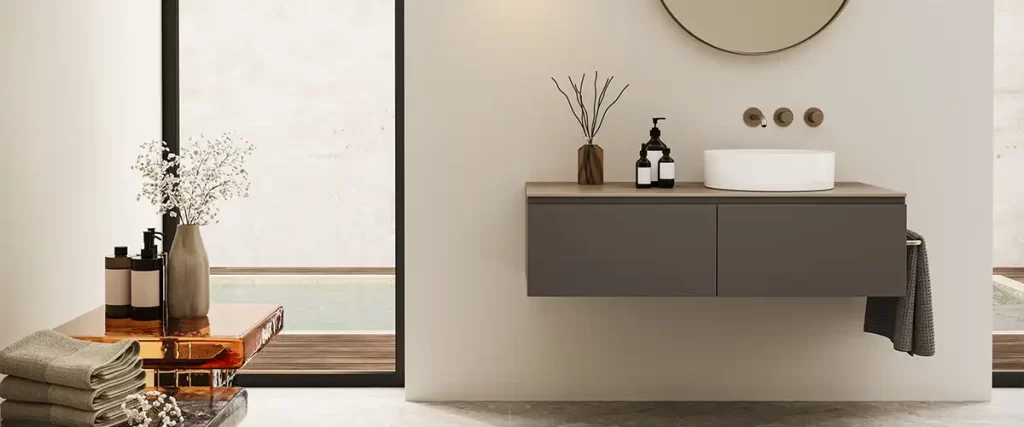
Floating vanities are mounted directly to the wall, leaving the floor space underneath open. This creates a lighter, modern look and makes cleaning easier.
Key Benefits:
They make smaller bathrooms feel larger and more open, simplify cleaning, and pair well with modern design styles. Proper wall reinforcement is important, especially for heavy stone countertops.
4. Corner Vanity
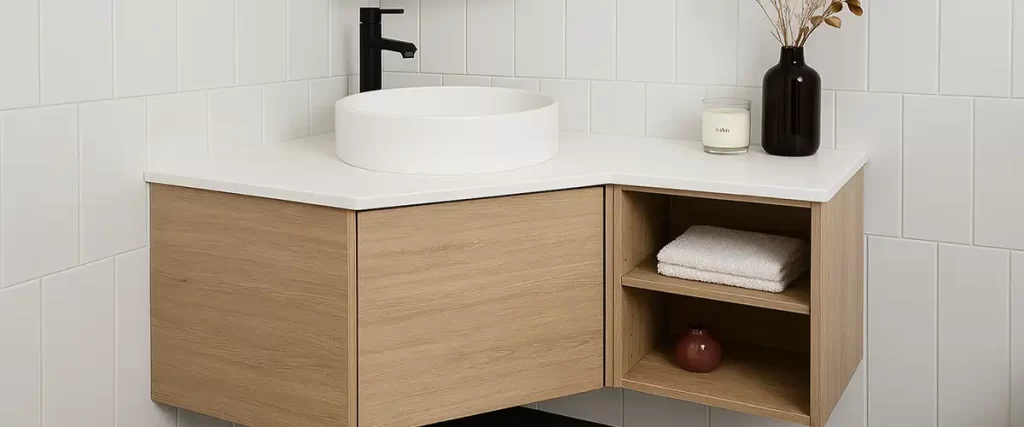
Corner vanities are perfect for compact bathrooms where every inch counts. They tuck neatly into unused corners and typically feature a rounded or angled basin.
Key Benefits:
Ideal for small or awkward layouts like guest bathrooms in older homes. They save space efficiently but offer limited counter surface and storage.
5. Vessel Sink Vanity
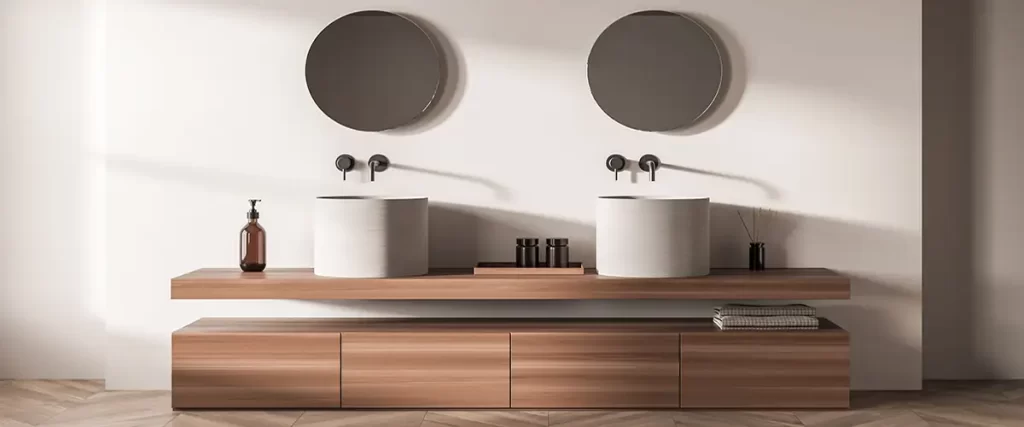
A vessel vanity features a bowl-shaped sink that sits on top of the counter. It’s a design statement. Bold, elegant, and often found in high-end hotels or remodeled master baths.
Key Benefits:
Creates an elegant focal point and allows for more cabinet storage underneath.
Considerations:
Requires a taller faucet and can be harder to clean around the base.
6. Under-Mount Sink Vanity
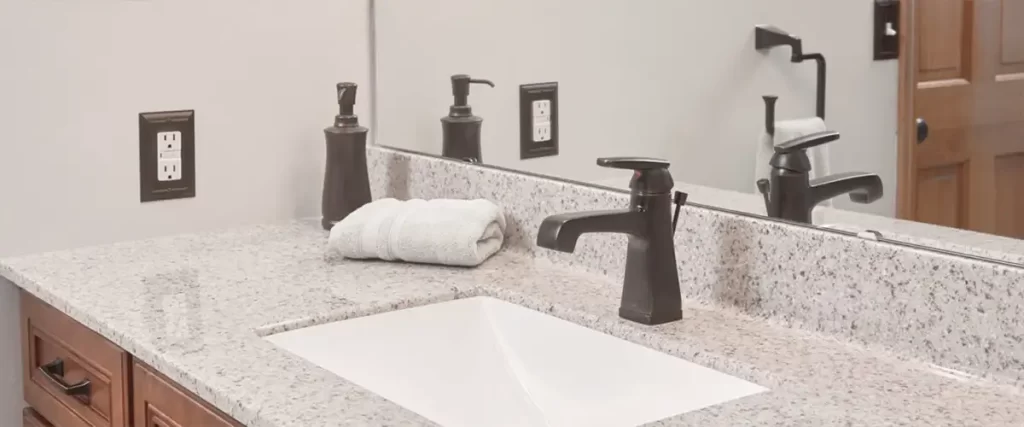
In this design, the sink sits below the countertop, creating a smooth, seamless surface. It’s popular among homeowners who want a clean, modern aesthetic without visible sink edges.
Key Benefits:
Looks sleek, makes countertop cleanup easy, and suits a wide range of materials.
Considerations:
Slightly reduces cabinet storage due to the recessed sink bowl.
7. Pedestal Sink
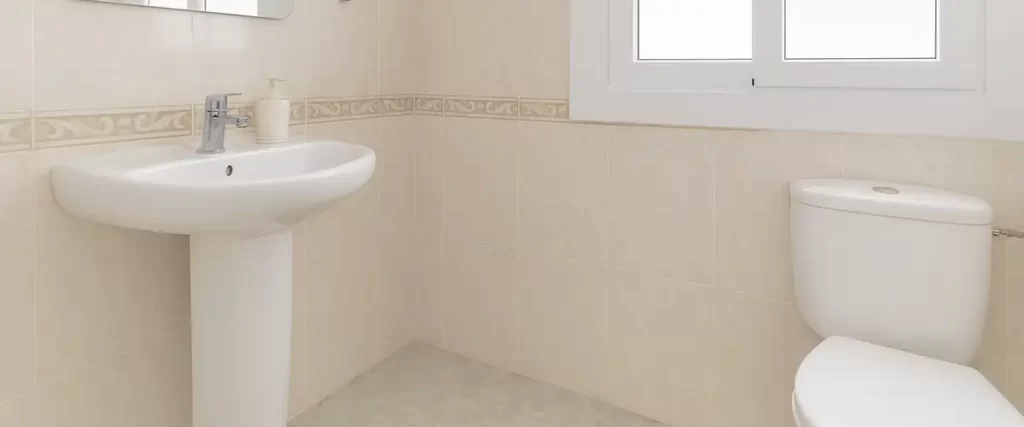
A pedestal sink is the simplest option. Just a basin supported by a single column. It’s elegant, timeless, and fits bathrooms with limited space.
Key Benefits:
In small powder rooms or guest bathrooms where you don’t need storage. It’s great for design simplicity but leaves no room for toiletries underneath.
Sink Configurations: Single vs. Double
The number of sinks in a vanity can completely change how the space functions. It affects layout, storage, and how comfortably multiple people can use the bathroom at once.
Single Vanity
A single-sink vanity is best for smaller bathrooms or guest spaces. It’s cost-effective and takes up less room while still providing adequate storage for one person.
Double Vanity
A double-sink vanity is ideal for master bathrooms or shared spaces. Couples in larger homes often choose these for convenience during morning routines. You’ll get more counter space and drawers. Though it takes up more wall width and plumbing.
Vanity Styles: Bringing Character Into the Bathroom
Each home’s design influences the type of vanity that feels natural in the space. Below are the main vanity styles trending among homeowners and designers.
| Style | Defining Traits | Common Materials |
|---|---|---|
| Traditional | Ornate moldings, decorative legs, and warm finishes. | Solid wood, marble, bronze hardware. |
| Modern/Contemporary | Clean lines, minimalist profiles, neutral tones. | MDF, laminate, glass, quartz. |
| Rustic/Farmhouse | Distressed wood, exposed grain, and vintage fixtures. | Reclaimed wood, matte finishes, open shelving. |
| Transitional | Mix of modern simplicity and classic touches. | Painted wood, brushed metal, quartz tops. |
| Industrial | Raw, practical feel with exposed metal frames. | Wood veneer, black steel, concrete tops. |
For Anne Arundel County homes, transitional and farmhouse styles are especially popular because they blend well with mix of historic and modern architecture.
Vanity Materials: Strength and Style That Last
When choosing materials, durability is just as important as looks. Humidity and temperature changes can take a toll in Maryland’s coastal climate.
- Natural Stone (Granite, Marble, Quartz): Durable, heat- and moisture-resistant, ideal for high-use bathrooms.
- Plywood: Great balance of strength and cost. It resists warping better than solid wood and can be painted or stained.
- Solid Wood: Premium choice for traditional or farmhouse bathrooms; requires sealing against moisture.
- Laminate/Particleboard: Budget-friendly but less durable. Works for guest baths or low-humidity environments.
Choosing the Right Vanity for Your Space
Choosing the right vanity comes down to how well it fits your space and daily routine. Before you decide, think through the following points.
- Space and Size: Measure carefully. Leave enough room for drawers and doors to open fully and for comfortable movement.
- Storage Needs: Decide if you need drawers, cabinets, or open shelves based on who uses the bathroom.
- Plumbing Setup: Keep existing plumbing where possible to avoid major remodeling costs.
- Lighting and Mirror Pairing: Your vanity area should have balanced lighting. Consider adding LED strips or sconces to complement the design.
If you’re remodeling a bathroom in Annapolis, Severna Park, or Pasadena, a professional bathroom remodeler can help you balance the look, function, and long-term durability that fit your home’s design.
Choosing the Vanity That Fits Your Bathroom Best
Bathroom design starts with the right foundation, and that’s your vanity. The types of bathroom vanities you can choose from today give you incredible flexibility in style, storage, and space management.
Whether you prefer a freestanding wood vanity for a traditional look or a floating vanity for a modern bathroom, the right choice will always combine beauty, practicality, and build quality suited to your space.
If you’re planning a remodel in Anne Arundel County, Maryland, explore your vanity options with a trusted local bathroom remodeling expert who understands how to balance design with function in our regional homes.
Ready to start your bathroom remodel? Contact us Brucksch and Sons Remodeling to discuss design ideas, material options, and the best vanity style for your space. Call (443) 261-9582 to schedule your consultation with our local remodeling team in Anne Arundel County.
